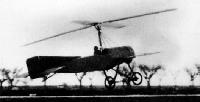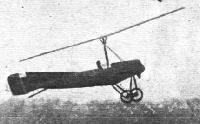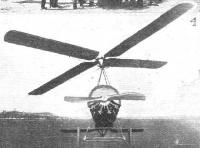
Cierva (автожиры X. Сиервы)
<...>
Экспериментируя с моделями, Сиерва опытным путем пришел к применению несущего винта с шарнирно закрепленными гибкими лопастями несущего винта для преодоления дисбаланса в подъемной силе между идущими по потоку и навстречу ему лопастями. В 1922 году на основе этой теории построили вариант С.4 с четырехлопастным несущим винтом, лопасти которого крепились к втулке на шарнирах. Эта машина впервые успешно взлетела 9 января 1923 года. Хотя в этом полете аппарат пролетел всего 183 м, он подтвердил правильность выбранной концепции. В конце того же месяца автожир С.4 за 4 минуты пролетел 4 км по замкнутому маршруту на высоте около 30 м. С.4 оснащался ротативным мотором Rhone 9Ja мощностью 110 л. с. (82 кВт). В июле 1923 года взлетел автожир С.5 с аналогичным мотором и трехлопастным несущим винтом. После этого Сиерва, ранее финансировавший свои работы из частных источников, получил субсидии от правительства Испании.
<...>
Описание:
- Cierva (автожиры X. Сиервы)
- Flight, May 1923
THE CIERVA "AUTOGIRO" - Flight, August 1923
MORE ABOUT LA CIERVA "AUTOGIRO
Фотографии
-
Aeroplane Monthly 1979-05 / P.Capon - Cierva's first autogiros (2)
The C.4 was powered by an 80 h.p. Le Rhone rotary and was based upon the shortened fuselage of a Sommer monoplane.
-
Мировая Авиация 95
9 января 1923г.: спроектированный испанцем Мануэлем де ла Сиерва, автожир С.4 Autogiro совершил первый успешный полет, преодолев 4-км круг на мадридском аэродроме "Cuatro Vientos".
-
Flight 1923-05 / Flight
View of the "Autogiro" in flight.
-
OS 1 / H.Cowin - X-Planes
The Cierva C-4, brainchild of Spaniard, Juan De La Cierva and his first demonstrably successful autogiro. It was completed at the end of 1922 and a month later took the aviation world by storm with a 4 kilometre, or 4.375 yard closed-circuit flight officially timed at 3 minutes, 30 seconds, representing a speed of 42.6mph, when flown by Flying Officer Gomez Spencer at an airfield near Madrid, on 31 January 1923. This at a time when what few helicopters there were would be pressed to achieve 4mph, Cierva had come to rotary wing design in 1919 unencumbered by any helicopter preconceptions. What Cierva was seeking was to produce an unstallable aircraft, that is, one that would continue to fly rather than to drop out of the sky should it be flown too slowly. It just so happened that he chose to exploit the properties of an autorotating rotor system. By this means the autogiro can descend back to earth at angles of up to 80 degrees, but land gently within a space of a few dozen feet at most. Initially troubled by the same instability problems that were besetting the aspirant helicopter developers, Cierva's non-driven rotor troubles proved far easier and quicker to tame. Indeed, his pioneering of the flapping and dragging rotor arm hinges was to solve many of the helicopter's longest standing problems at a stroke.
-
Aeroplane Monthly 1979-05 / P.Capon - Cierva's first autogiros (2)
The C.4 at Getafe aerodrome, Madrid, in 1922. The rotor blades had a hinge which allowed them to “flap.”
-
Flight 1925-11 / Flight
While still working on No. 3, Senor de la Cierva conceived the idea of stabilising his machine by hinging the blades to the axle, and this was done in No. 4, which is shown in Fig. 4. Lateral control was provided by tilting the axis of the windmill, but it was found at once that the pilot's strength was insufficient to work the controls.
-
Aeroplane Monthly 1979-05 / P.Capon - Cierva's first autogiros (2)
In its final form, with a locked rotor head and ailerons on outrigger spars, it made the first successful autogiro flight on January 17, 1923.
A rebuilt machine, shown in Fig. 5, was provided with two small non-lifting ailerons carried on streamlined spars, the windmill axis being rigidly fixed. The machine shown in Fig. 5 made several successful flights, the first being made on January 31, 1923, and being of four minutes duration. -
Flight 1923-09 / Flight
Rear and front views of the Cierva "Autogiro."
-
Aeroplane Monthly 1979-05 / P.Capon - Cierva's first autogiros (2)
The first official demonstration of an autogiro took place at Getafe aerodrome on January 22, 1923, the C.4 being flown by Lt Alejandro Gomez Spencer.
-
Aeroplane Monthly 1979-05 / P.Capon - Cierva's first autogiros (2)
The C.5 at Cuatro Vientos aerodrome, Madrid, in 1923. It utilised the fuselage of the earlier C.2, having a 110 h.p. Le Rhone as its powerplant.
-
Flight 1925-11 / Flight
Autogyro No. 5,. shown in Fig. 6, incorporated the same principles, but improvements were effected in the detailed design. This machine had only three blades, and also made several successful flights. It was, however, damaged very badly while taxying. By this time the Spanish aeronautical authorities took over the further development of the Autogyro, three machines of the type 6 being built of which the third is that now being tested at Farnborough.
-
Aeroplane Monthly 1979-05 / P.Capon - Cierva's first autogiros (2)
Pilot A. Spencer lounges on the fuselage of the short-lived C.5, which ended its life in a crash in July 1923.
-
Flight 1923-09 / Flight
Diagram showing the forces in the lifting vanes.
- Фотографии












